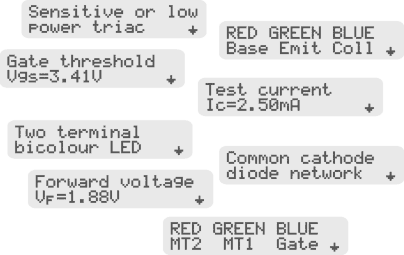 |
 |
 |
 |
 |
| Data Sheet |
Customer Comments |
Review - Television Mag |
Review - EPE Mag |
FAQs |
|
Features |
- Automatic component identification.
- Automatic pinout identification, connect the test leads anyway round.
- Gain measurement for transistors.
- Gate threshold measurement for Enhancement mode MOSFETs.
- Depletion mode detection for MOSFETs.
- Forward voltage drop measurements of diodes, LEDs and transistor base-emitter junctions.
- Base-Emitter shunt resistor detection.
- Collector-Emitter diode detection.
- Intelligent diode network descriptions.
- Short circuit detection between any 2 or 3 junctions.
- 2 Line scrollable LCD.
- Colour coded, universal clips, now gold plated.
- Simple two button control.
- Auto and manual power-off.
- Alkaline battery supplied.
- Includes comprehensive illustrated user guide.
- Only 103mm x 70mm x 20mm
|
|
 |
| Ask about our range of colours available |
 |
|
Components
Supported |
- Bipolar transistors
- Diode protected transistors (C-E)
- Resistor shunted transistors (B-E)
- Darlingtons
- Diodes
- Diode Networks
|
- Enhancement mode MOSFETs
- Depletion mode MOSFETs
- Junctions FETs (JFETs)
- Sensitive Thyristors
- Sensitive Triacs
- LEDs and Bicolour LEDs
|
|
|
The Atlas offers unrivalled functionality and style. The
analysis portfolio is bigger than ever, offering enhanced message display and intelligent
component identification. This superb instrument displays incredibly detailed information
in scrollable pages. The Atlas combines an impressive analysis portfolio with unequalled
ease of use. Connect your component any way round and let the Atlas do the rest. It will
measure the gain of transistors, the threshold voltage of MOSFETs, and semiconductor
voltage drops. It will even identify special component features such as diode protection
on transistors or resistor shunts on Darlingtons. The new
intelligent analysis algorithms makes life much easier when dealing with unknown
components. For example, the Atlas will tell you if it has detected many different types
of diode networks such as series types, common cathode, common anode and even inverse
parallel types. Additionally, the Atlas knows the difference between normal diodes and
LEDs and it will correctly identify and characterise both LED chips in two terminal and
three terminal bicolour LEDs. |
|
|
Summary Technical Specifications
| Parameter |
Notes |
Min |
Nom |
Max |
Units |
| Peak test current into
short circuit (ISC) |
1 |
-5.5 |
|
5.5 |
mA |
| Peak test voltage across
open circuit (VOC) |
1 |
-5.0 |
|
5.0 |
V |
| Bipolar transistor
collector test current (IC) |
2 |
2.3 |
2.5 |
2.7 |
mA |
| Bipolar transistor
collector-emitter test voltage (VCEO) |
2 |
2.0 |
|
3.0 |
V |
| Bipolar transistor
measurable gain (HFE) |
3 |
4 |
|
65000 |
- |
| Bipolar gain accuracy |
2, 3 |
� 3% of reading � 5 HFE |
| EM MOSFET drain test
current (ID) |
|
|
2.5 |
|
mA |
| EM MOSFET drain-source
test voltage (VDS) |
|
2.0 |
|
3.0 |
V |
| EM MOSFET gate-source
voltage range (Vgs) |
|
0 |
|
5.0 |
mA |
| EM MOSFET gate-source
threshold accuracy |
|
|
4 |
|
% |
| Silicon diode junction
test current (IF) |
|
3.3 |
4.4 |
5.0 |
mA |
| Triac/Thyristor gate
current (IG) |
|
|
4.5 |
|
mA |
| Triac/Thyristor test
current |
|
|
4.5 |
|
mA |
| Dimensions |
|
103 x 70 x 20 |
mm |
|
| Notes |
| 1. Between any pair of test
clips. |
| 2. For BJTs with an HFE between 5 and 2000, Gain accuracy
valid for gain < 2000. |
| 3. Specified for IC=2.5mA and VCEO=2.5V. |
| 4. Subject to acceptable LCD visibility. |
|
|